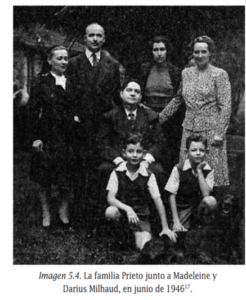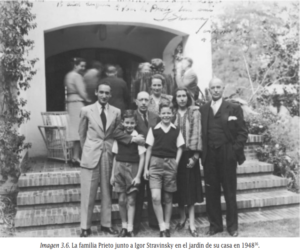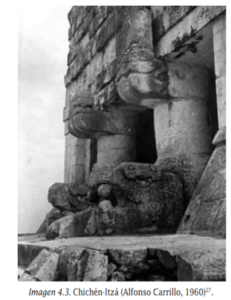We are happy to launch a new series, Composers to Discover! featuring essays by students in the Public Musicology Certificate Program at Columbus State University. Coordinated by Dr. Reba Wissner, this unique program that trains students with real-world experiences in writing and research in a broad range of music topics. Our series of essays offer insights on important composers who we hope will become better known.
Our first essay is by Angie Lorena Bolivar Alfonso, a violist and educator. The subject is composer Maria Teresa Prieto, who was born on April 22 — so we are only a little late in celebrating her birthday! In a happy coincidence, that day is Angie’s birthday as well!
A Composer Between Two Worlds — Maria Teresa Prieto
By Angie Bolivar-Alfonso
I highly recommend the deep research of Tania Perón Pérez who recently published the book: La compositora asturiana María Teresa Prieto (1895-1982): creación y añoranza en el México del siglo XX. (Universidad de Oviedo. 2020, based on her 2014 thesis). Much of the information found in this blog is based on her research.
It’s time to celebrate the life of Maria Teresa Prieto, who, in exile from her country, found musical identity between two worlds: Spain and Mexico. Prieto was born on April 22nd, 1895 in Oviedo, Asturias (Spain) surrounded by a middle-class family passionate for the arts. Her parents, Carlos Prieto Delmez and María Fernández de la Llana, instilled in her and her siblings, Margarita, Carlos, and Maria, a strong love for music, encouraging their main instruments, piano, voice and violin. At seven, Prieto began her musical studies at the Academia Provincial de Bellas Artes San Salvador de Oviedo, taking solfege and choral classes with Rufino González-Nuevo (1831-1921). In 1906, under the guidance of Saturnino del Fresno y Arroyo (1867-1952), Prieto initiated her Piano studies that continued until her acceptance at the National Conservatory of Madrid. The years in Spain did not bring many compositions to life, her miniature for piano Escena de niños (1917) is the only piece that we can recall, mentioned briefly on the journal Musica: Album-Revista Musical Vol. 19, October 1, 1917. From 1918 to 1929, Prieto focused her musical journey on teaching at the Hospicio Provincial, as a replacement for her sister Margarita. Not satisfied with this way of life, Prieto resigned from this position to begin her compositional studies at the conservatory.
In 1930, her compositional exploration formally began with Benito Garcia de la Parra (1884-1953), who nurtured her Neo-Classical approach to music. Prieto was obsessed with the past, exploring baroque compositional techniques, specifically the implementation of different musical modes. In 1935, the unfortunate death of her sister Margarita, and then her mother a couple of months later, left her alone in Madrid. Her siblings, Sor Maria Prieto (in a convent in Spain) and Carlos Prieto who was already living in Mexico, encouraged her to finish her studies at the conservatory.

Maria Teresa, Second from right
In 1936, when Prieto was 40 years old, the Spanish Civil War began and with that a new chapter in her musical life. Her brother, Carlos Prieto, a successful philanthropist and merchant, encouraged her to leave Spain and move to Mexico to live with his family. A new artistic world awaited her, full of nationalistic ideas and intellectual discussions. Mexico was the second home for many exiled Spanish artists, motivating her brother to host a weekly artistic meeting for scientists, thinkers, painters, writers and musicians. Carlos Prieto’s house in San Angel Inn, was situated close by Diego Rivera and Frida Kahlo’s home. The meetings were attended by intellectuals such as Ricardo de Alcázar, Salvador de Madariaga and Juan Rulfo, musicians from all over the world including from the exile: Eduardo Martínez Torner, Rosita García Ascot, Rodolfo Halffter, Adolfo Salazar and Jesús Bal y Gay, and internationally recognized figures such as Igor Stravinsky, Leonard Bernstein, Jascha Heifetz, Darius Milhaud, Erich Kleiber, Carlos Chávez and Manuel Ponce.

Carlos Prieto not only opened up his house and family to Maria Teresa, supporting her economically to continue her compositional journey, but also connected her with like-minded individuals who nurtured her path. Prieto’s permanent place was in the attic of the house, which her brother adapted to support her career. The attic had a piano and a small balcony.

One morning in 1960 outside of her Attic window a surprising visitor came to stay: a bird got caught in the melodies of her compositions and came to visit every day. Maria Teresa decided to open the window and let it come inside the room. The bird perched on the bars at the base of the bed, accompanying with trills in C minor the passages that Maria Teresa improvised on the piano. She baptized it Pirulín and wrote a book called Pirulín, narración verídica (1962) that she distributed among her close friends. Its introduction reads: “Lead me to write this narrative, to highlight a phase of my life that, punctuated by a new and unique emotion, makes it inwardly more luminous and more adept towards the beings around us. I wish I would never have to leave this spiritual environment full of poetry and softness, bestowed by divine grace.”
Prieto’s musical exploration brought her to study with Manuel Ponce, Carlos Chávez (who premiered some of her main compositions) and Darius Milhaud at Mills College in Oakland, California. The development of her musical language was highly influenced by these acquaintances as well as her own heart divided between Mexico and Spain.
Highlighting her palette of compositions, Sinfonia Asturiana (1942-1943), reflects the nationalistic idioms learned from Manuel Ponce reflecting the longing and memories of her homeland. It is articulated in three movements, developing the first and third in sonata form, and the second an accompanied melody in the form of a lied.
The Influence of Mexico’s roots on her journey is presented in the Symphonic Poem Chitzen Itza (1944). This piece was influenced by Carlos Chavez’ indigenous movement, searching for the connection between Indigenous music and Western culture.
 In 1943, Prieto visited the Mayan ruins of Chitzen Itza in the northern Yucatan Peninsula for fifteen days, inspiring the musical elements of her final Symphonic Poem. In C major, the work develops three main themes historical topics of the city structure: The Ball Game, the Feathered Serpent, and Sacrifice in the Sacred Cenote.
In 1943, Prieto visited the Mayan ruins of Chitzen Itza in the northern Yucatan Peninsula for fifteen days, inspiring the musical elements of her final Symphonic Poem. In C major, the work develops three main themes historical topics of the city structure: The Ball Game, the Feathered Serpent, and Sacrifice in the Sacred Cenote.
One of the ensembles that Prieto explored most frequently was the voice and piano combination. Her famous compilation Seis Melodías para voz y piano (1938-1941), was the first cycle of songs inspired on nationalistic popular tunes from Spain:
- En las palmas de la noche (1938)
- Donaire (1938)
- Canción de cuna (1941)
- Pastoral (1938)
- Cautiva (1940)
- Alto pinar (1939).
Prieto’s compositional exploration also reflects her love for chamber music. Her third and most famous quartet, the Modal String quartet (1957), was dedicated to her brother Carlos Prieto and reflects the guidance of her first compositional teacher Benito Gracia de la Parra. It was divided into four movements as in the previous quartets, but this time with a modal perspective: Doric, Lydian, Aeolian, and Ionic. Unfortunately, there is not a public domain recording of this quartet.
The last piece I want to mention that highlights Prieto’s musical journey is her Adagio and Fuga for Violoncello and Orchestra (1948), dedicated to her nephew, who years later became a professional cellist.
At the age of 82, Prieto composed her last piece for voice and piano Anoche, cuando dormía (1977), dedicated to her brother Carlos Prieto and based on a poem by Antonio Machado (1875-1939).
Prieto’s health deteriorated rapidly and on January 24, 1982, she died in Mexico surrounded by her family. Her music was largely forgotten after her death, but we can celebrate that recent research is now bringing it back to life again.
